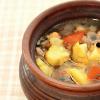Foie gras is a food product made from the liver of a duck or goose that has been specially fattened. According to French law, when talking about the concept of what foie gras is, we are talking about the liver of a duck fed by force. However, outside of France, poultry is sometimes raised using breastfeeding. A pastry containing a pâté of similar meat and bacon was formerly known as "Strassbourg Pie".
Foie gras is a popular and very famous delicacy that comes from the aroma of this dish is described as rich, thin and buttery, unlike the usual duck or goose liver. This product is sold in its natural form or used as an ingredient in mousses, parfaits or pâtés, and can also be used as a garnish with other foods, such as steak.
As early as 2500 B.C. The ancient Egyptians learned what foie gras was after seeing that many birds could be force-fed and began the practice. Then a similar type of geese feeding spread from Egypt to the countries of the Mediterranean basin.
Today, France is the leading producer and consumer of duck and goose foie gras. In 2005, the country produced 18,450 tons of this product, of which 96% was produced from duck liver, the rest from goose liver.
In France, the concept of what foie gras is today is quite extensive, since this delicacy exists in various forms, legally enshrined, and includes both expensive and cheap varieties.

So, foie gras ENTIER (whole) is made from one or two whole lobes of the liver and goes on sale boiled, semi-cooked or raw.
Another variety is foie gras made from pieces of liver put together. The block of this product, fully prepared, consists of 98% natural delicacy.
If we are talking about foie gras "with pieces", it must contain at least 50% goose liver and at least 30% duck liver.
In addition, there are foie gras pate, foie gras mousse (both products must contain at least 50% goose liver or even more), goose liver parfait (75% or more foie gras) and other convenience foods (without requirements). to composition).
A fully finished product is usually sold in any glass container or in metal cans for long-term storage. Fresh foie gras is generally not available for sale except on the eve of major holidays. The frozen product is sometimes sold in large supermarkets.

As a rule, French dishes with this product are cooked on low heat, since the fat contained in it melts very quickly. American and other recipes usually call for hot foie gras rather than warm or cold.
In Hungary, goose foie gras is traditionally fried on top of which is then poured over the finished product and left to cool. This dish is also eaten warm. In other parts of the world, foie gras is used in dishes such as rolls, pasta fillers, or served on a steak as a side dish.
As already mentioned above, given the characteristics of what foie gras is, the traditional method of its preparation is low-temperature methods. This delicacy is also often served seasoned with truffles and other delicacy mushrooms. Fans will appreciate accompanying it with brandy or cognac.


